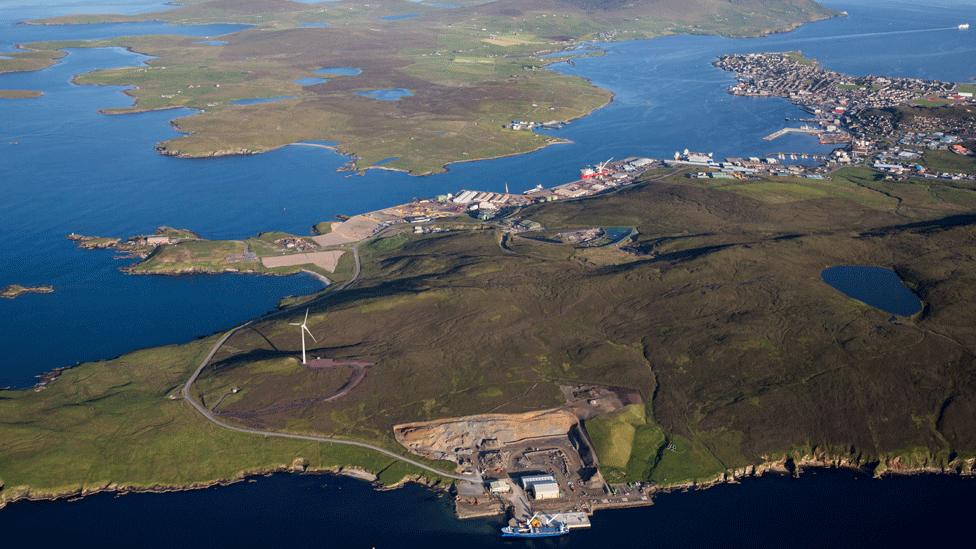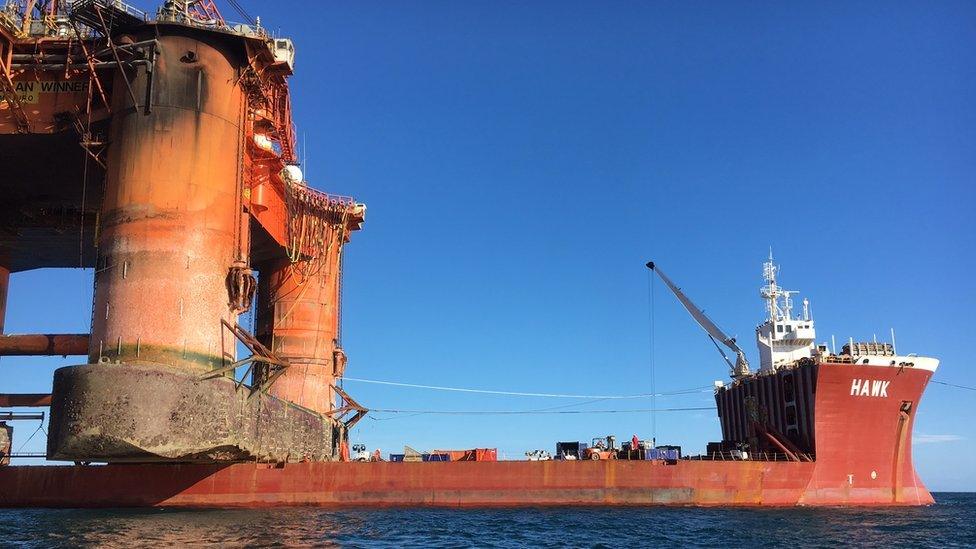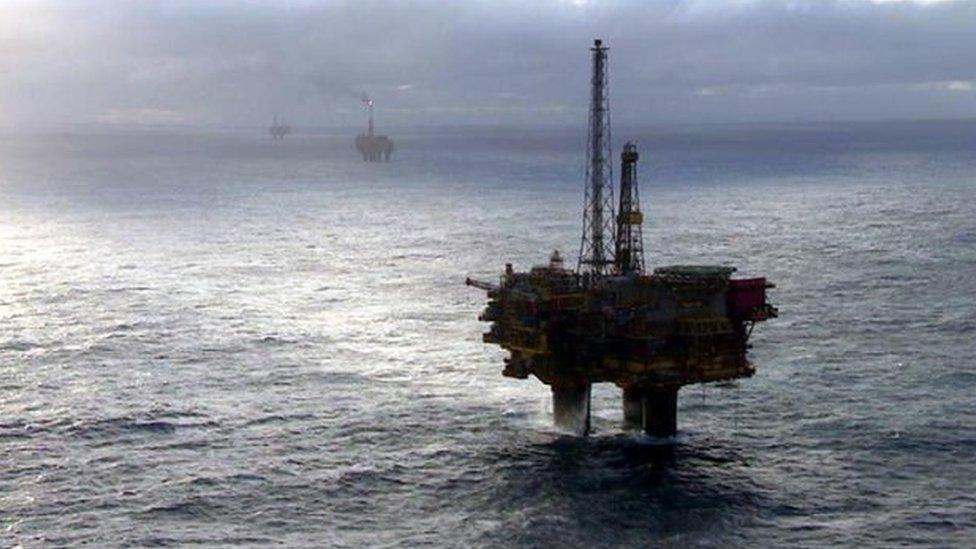Q&A: North Sea decommissioning
- Published

Dales Voe supports the offshore industry but little decommissioning work is onshore
Is Scotland set to miss out on a burgeoning North Sea decommissioning market?
Oil and Gas UK has said more than 100 platforms are expected to be completely or partially removed from the UK and Norwegian continental shelves by 2025.
More than 1,800 wells are also scheduled to be plugged and abandoned and 7,500km of pipeline decommissioned.
The GMB union has raised concerns about lucrative decommissioning contracts going abroad, and has called for urgent action to get Scottish ports and fabrication yards "decommissioning ready".
Here, BBC Scotland looks at the potential value of decommissioning work, Scotland's position in this market, and the potential cost to taxpayers.
Q: Is the decommissioning market set to grow?
A: Decommissioning is a growing, if still emerging, market, according to a report by Oil and Gas UK published last week.
Figures in Decommissioning Insight said the market accounted for 5% of total industry expenditure, up from 2% in 2010.
It said £1.1bn was spent on decommissioning in the UK and £1bn in Norway last year. This compared with £800m and £770m in the same countries in 2014.
Yet there had not been a rush by the sector to decommission older offshore assets, despite low oil prices.
It said there were various reasons why companies were delaying decommissioning, including: cash-flow constraints, the possibility of new ways to extend field life and the hope that decommissioning costs could reduce in future.
The report also warned against "premature decommissioning", with up to 20 billion barrels of oil and gas still said to be recoverable from the North Sea.
It added that the remaining value of fields nearing decommissioning could increase by more than 50% if there were successful measures to reduce costs and increase production.

The Transocean Winner rig was taken to Turkey to be scrapped
Q: How much of the market does Scotland currently attract?
A: It has been claimed that Scottish yards are behind their English counterparts in the race for contracts, with Shell facilities north of Shetland being scrapped in Hartlepool.
GMB said Scotland was missing out on lucrative work to deconstruct topside units moved from their offshore sites.
It said work was needed to create a decommissioning hub linked to transport infrastructure, which encouraged collaboration among ports and relevant agencies.
However, chief executive of Lerwick Port Authority (LPA) on Shetland, Sandra Laurenson, said the numbers in the decommissioning market were misunderstood.
She said onshore decommissioning was a tiny market, with most of the work undertaken off-shore, including well plugging and abandonment, platform shutdown and removal.
She said work which required a yard only equated to about 2-3% of the total cost. And onshore projects only needed a small workforce, with about 100 people working on decommissioning projects at LPA.
She said off-shore work was being carried out by Scottish companies. For example Shell's Brent decommissioning has involved 1,500 people working for locally-based companies, with staff based at office headquarters in Aberdeen or offshore.
Oil and Gas UK backed this and said a significant amount of the decommissioning work was offshore, much of which was contracted though UK and Scottish companies.
Q: Why have a number of recent decommissioning contracts gone to other countries?
A: A Norwegian port recently won the contract to decommission Maersk's Janice Floating Production Unit.
While earlier this year, an oil rig wrecked off the Western Isles was taken to a Turkey to be chopped up for scrap.
So why has Scotland missed out on these contracts?
The first issue is the task of lifting huge topside rigs, and there are few vessels large enough to carry out this specialist work.
The second issue is finding a deepwater yard with a track record in decommissioning.
CEO Sandra Laurenson said LPA was one of two UK yards (the other in Teeside) with a track record in large decommissioning projects.
She said the company had future aspirations to construct an ultra-deep-water quay, she said, but the market was still too immature to justify the investment.
The GMB union has also claimed that oil and gas companies had benefited from tax breaks by taking decommissioning work abroad. It also said there had been inadequate investment in yards.
Scotland's Minister for Business, Innovation and Energy Paul Wheelhouse has urged the UK chancellor, Philip Hammond, to use his Autumn Statement this week to improve access to decommissioning tax relief.
What capacity could Scotland have for decommissioning in the future?
A: Oil and Gas UK said the supply chain in Scotland and in the rest of the UK needed to be improved.
It said the industry was working together to develop decommissioning solutions that would improve competiveness and comply with health, safety and environmental needs.
With £17.6k expected to be spent on decommissioning over the next ten years, and more than 80% of the activity not yet contracted out, Oil and Gas UK said there was opportunity to develop a competitive supply chain.
Many parts of the sector in Scotland claim to be preparing for an increase in end-of-life decommissioning work.
Lerwick Port Authority (LPA) on Shetland recently completed an £11.95m extension of its Dales Voe quay, creating 40,000 sq m of laydown space their workplace.
LPA also has future aspirations to construct an ultra-deep-water quay, but is "waiting for the market to ripen".
A 25,000 sq ft decommissioning facility is set to open at the Port of Dundee in early 2017. The facility is a partnership between Forth Ports and Augean North Sea Services.
Aberdeen Harbour is also progressing expansion plans, with a feasibility study proposing an expansion of Aberdeen Harbour into Nigg Bay,
The Montrose Port Authority has also said they could play a key part in the decommissioning process, if work was broken up into smaller parts. It said it had invested about £15m in the port since 2012.
What could decommissioning cost, and how much will taxpayers need to fund?
A: Oil and Gas UK's most recently published figures estimate the cost of decommissioning across the UK Continental Shelf (UKCS) as a whole would amount to circa £50bn over the next three decades and more. It said work was currently underway to "high-grade" this estimate.
Under UK rules, the taxpayer will foot half the total decommissioning bill through tax rebates.
However, the GMB said the bill could actually be more than £100bn, and that taxpayers may have to fund between 50 and 75% of that.
It said that some older fields were also subject to Petroleum Revenue Tax (PRT) and decommissioning costs on these could be carried back indefinitely.
This could mean there is the possibility of an additional 25% refund - so the combined bill for the taxpayer could be 75%.
Oil and Gas UK said tax relief would vary on a "field by field and company by company basis" and was covered by the UK Exchequer.
- Published21 November 2016
